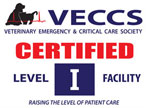Date:
This article recently appeared in the Charleston Mercury written by Alan E. Green, DVM and Kristin Welch, DVM, DACVECC
Beware of snakes as warmer weather arrives in the Lowcountry. Our outdoor pets are vulnerable these days, and it’s not just hunting dogs that are in danger.
Dr. Kristin Welch, who helped with this article, is the head of Emergency and Critical Care at Charleston Veterinary Referral Center and the only board-certified critical-care specialist in South Carolina. She reminds us that of more than 120 species of snakes identified in the United States, 20 of them are venomous. Those that are poisonous in South Carolina include three species of rattlesnakes as well as cottonmouth water moccasins, copperheads and coral snakes.
Snake bites are most commonly reported in April through September around here. Pine straw, brush and downed timber provide outstanding camouflage, and are the snakes’ preferred environment. Most bites in pets are to the face, neck and limbs as they sniff around. Typically, a cat or dog startles the snake, which makes a defensive strike. Luckily, 20-30 percent of snakebites are “dry,” meaning that the victim has not been poisoned.
When considering what makes a snake bite in one dog result in severe systemic illness, while another develops only a wound, one must consider “snake factors” and “victim factors.” The snake’s species, size and age, and whether the bite is offensive or defensive in nature influence the severity of situation. Rattlesnake and cottonmouth venoms are the most toxic. Rattlesnake venom is responsible for the majority of the illness and death. Larger and more mature snakes manufacture more venom and thus are a bigger risk.
Moreover, an offensive bite is much more dangerous. Imagine a snake stalking a mouse for prey before lunging and striking. This premeditated strike and venom delivery is made to kill. Contrast this with a dog running through the woods that accidentally steps near a copperhead. A surprise defensive bite injects a smaller volume of venom or may inject none at all.
The size of the victim, location of the bite and whether it is a dog or cat determine the severity of the result. Cats tend to be more resistant to snake venom than dogs, and perhaps due to their size and hunting behavior, tend to suffer snakebites to the torso. In contrast, dogs are most commonly bitten in their face, tongue, eyes and neck. Bites in these areas are more serious since the venom is often delivered directly into the victim’s bloodstream.
Interestingly, immediately after a snake bite there is no difference in the appearance of the bite wound whether or not venom has been delivered. If a dog has a thick coat, fang marks may not even be seen. Or, there may be one to six punctures seen and the first sign of a problem is pain at the site. Bruising and swelling at the site might occur within minutes to hours. The dog or cat may become weak, dizzy and nauseous, have muscle tremors or an elevated respiratory rate.
It is crucial to obtain immediate veterinary care. Within minutes, a bite to the tongue can result in swelling of the upper airway and respiratory distress. It is very important to remain calm and avoid exciting your injured friend. Keeping the dog or cat as calm as possible while en route to your veterinarian will minimize the spread of venom through the body.
If it is safe to do so, identify the snake. A photo or description of the size, coloring and markings will aid in determining if it is a rattlesnake, cottonmouth, copperhead or coral snake. There are also a number of nonpoisonous snakes that have similar markings to their poisonous counterparts. In the majority of snake bites, the species is unable to be definitively identified, therefore is it critical that all snake bites are treated as if from a poisonous snake.
Your veterinarian will immediately assess your pet’s overall health status, paying special attention to the heart, lungs, neurological system and bite wound. Baseline blood work will be obtained to evaluate for problems with clotting, electrolyte imbalances and organ damage. A blood pressure and electrocardiogram may be completed to evaluate for effects on the cardiovascular system. The bite-wound location will be measured periodically throughout hospitalization to assess for worsening or response to treatment. More than likely, your pet will be hospitalized for 12-48 hours for intravenous fluids, pain medications and possibly anti-venom therapy. Anti-venom provides antibodies that bind and inactivate venom components thereby halting tissue and organ damage.
All snake bites should be considered an emergency. Immediate veterinary care can be lifesaving.







